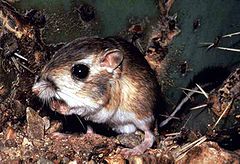Heteromyidae
| Heteromyids Temporal range: Early Miocene–Recent |
|
|---|---|
 |
|
| Fresno kangaroo rat (Dipodomys nitratoides) | |
| Scientific classification | |
| Kingdom: | Animalia |
| Phylum: | Chordata |
| Class: | Mammalia |
| Order: | Rodentia |
| Family: | Geomyoidea |
| Family: |
Heteromyidae Gray, 1868 |
| Subfamilies | |
Dipodomyinae
Heteromyinae
Perognathinae
Heteromyidae is a family of rodents consisting of kangaroo rats, kangaroo mice, pocket mice and spiny pocket mice. Most heteromyids live in complex burrows within the deserts and grasslands of western North America, though species within the genus Heteromys are also found in forests and their range extends down as far as northern South America. They feed mostly on seeds and other plant parts, which they carry in their fur-lined cheek pouches to their burrows.
Although they are very different in physical appearance, the closest relatives of the heteromyids are pocket gophers in the family Geomyidae.
There are about fifty-nine members of the family Heteromyidae divided among six genera. They are all small rodents, the largest being the giant kangaroo rat (Dipodomys ingens) with a body length of 15 cm (6 in) and a tail a little longer than this. In many species the tail is tufted and is mainly used for balance. Other adaptations include partially fused vertebrae in the neck, short fore limbs and much enlarged bullae (bubble-shaped bones in the skull). The skulls vary widely across the group but they are all thin and papery and do not have the robust cranial crests and ridges found on the skulls of members of the family Geomyidae. The skull has other peculiarities. There is an extra hole that penetrates the rostrum, distinctive occluded teeth and the masseter muscle, which moves the lower jaw, is set far forward on the snout, an arrangement found in squirrels, beavers, pocket gophers, heteromyids and a few other groups. The dental formula is 1/1, 0/0, 1/1, 3/3 making twenty teeth in total. In the kangaroo rats, the teeth continue to grow all the time, being worn away as the animal chews. The molars have two-lobed cusps. The upper incisors are grooved and the enamel on the molars is quickly worn away by chewing leaving the dentine exposed. In the kangaroo rats they are unrooted but in the pocket mice they have roots.
...
Wikipedia
